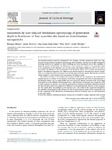Mostrar o rexistro simple do ítem
Assessment by laser-induced breakdown spectroscopy of penetration depth in limestones of four nano-biocides based on silver/titanium nanoparticles
| dc.contributor.author | Mateo, María Paz | |
| dc.contributor.author | Becerra, Javier | |
| dc.contributor.author | Zaderenko Partida, Ana Paula | |
| dc.contributor.author | Ortiz, Pilar | |
| dc.contributor.author | Nicolas, Gines | |
| dc.date.accessioned | 2022-12-16T14:12:59Z | |
| dc.date.available | 2022-12-16T14:12:59Z | |
| dc.date.issued | 2022-10-31 | |
| dc.identifier.citation | MATEO, Maripaz, BECERRA, Javier, ZADERENKO, Ana Paula, ORTIZ, Pilar and NICOLÁS, Ginés, 2022. Assessment by laser-induced breakdown spectroscopy of penetration depth in limestones of four nano-biocides based on silver/titanium nanoparticles. [online]. 2022. Vol. 58, p. 237–244. DOI 10.1016/j.culher.2022.10.010 | es_ES |
| dc.identifier.issn | 1778-3674 | |
| dc.identifier.uri | http://hdl.handle.net/2183/32215 | |
| dc.description.abstract | [Abstract]: Four biocidal treatments based on nanoparticles were designed and their penetration depths were char- acterized by laser-induced breakdown spectroscopy (LIBS) technique. This kind of biocidal nanoparticles are being studied to be employed in historic buildings and stone monuments due to their capability to inhibit the growth of biofoulings. The effectiveness of the treatment is related to the penetration depth of the nanoparticles in the limestone pore. For this reason, LIBS depth profiling was used in this work to characterize the diffusion of the nanoparticles in the limestone matrix and to compare the penetration depth of the different treatments. Four different nano-biocides based on silver/titanium dioxide nanopar- ticles were analysed by LIBS in limestone from Novelda quarry (Alicante, Spain). This limestone has been widely employed in both historical and contemporary buildings in Spain. The positive detection of the emission line of Ag at 338.289 nm was examined in the depth-related emission spectra as evidence of the presence of the silver nanoparticles and derived nanocomposites in the limestone matrix. The LIBS depth-profiles that were generated, showed a decrease of the Ag net signal with depth due to the diffusion of the nanoparticles in the limestone. Furthermore, the comparison of the in-depth sequences of spectra, and of the Ag depth profiles evidenced penetration differences between the nano-biocides which were explained by differences in the hydrodynamic diameter of the nanoparti- cles that would affect their diffusion in the limestone pore. The results of this assessment demonstrate the capability and potential of LIBS technique for the in-depth characterization of the nanoparticles and for the comparison of the effectiveness of nanoparticles biocidal treatments based on their penetration in the stone matrix. | es_ES |
| dc.language.iso | eng | es_ES |
| dc.publisher | Elsevier | es_ES |
| dc.relation.uri | https://doi.org/10.1016/j.culher.2022.10.010 | es_ES |
| dc.rights | Attribution-NonCommercial-NoDerivatives 4.0 International | es_ES |
| dc.rights.uri | http://creativecommons.org/licenses/by-nc-nd/3.0/es/ | * |
| dc.subject | Biocide | es_ES |
| dc.subject | Cultural heritage | es_ES |
| dc.subject | LIBS | es_ES |
| dc.subject | Depth analysis | es_ES |
| dc.subject | Limestone Silver/titanium nanoparticles | es_ES |
| dc.title | Assessment by laser-induced breakdown spectroscopy of penetration depth in limestones of four nano-biocides based on silver/titanium nanoparticles | es_ES |
| dc.type | info:eu-repo/semantics/article | es_ES |
| dc.rights.access | info:eu-repo/semantics/openAccess | es_ES |
| UDC.journalTitle | Journal of Cultural Heritage | es_ES |
| UDC.volume | 58 | es_ES |
| UDC.startPage | 237 | es_ES |
| UDC.endPage | 244 | es_ES |
| dc.identifier.doi | https://doi.org/10.1016/j.culher.2022.10.010 |
Ficheiros no ítem
Este ítem aparece na(s) seguinte(s) colección(s)
-
CIT-LAIL - Artigos [31]






